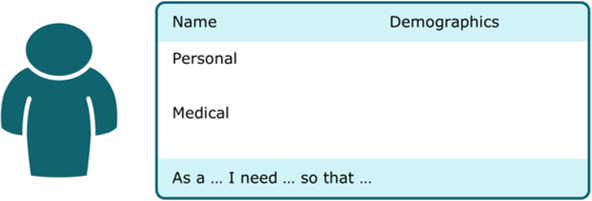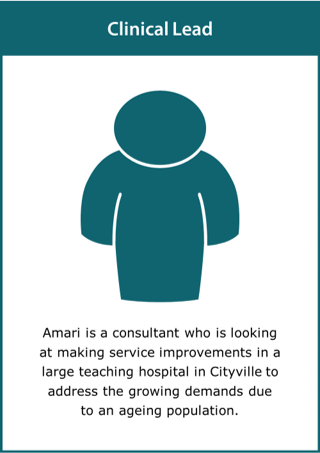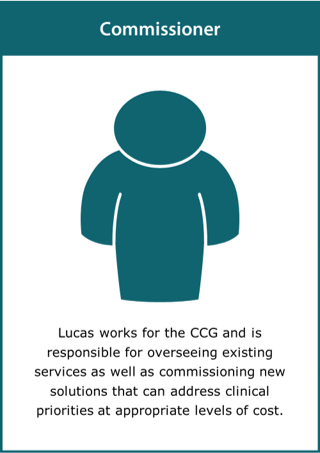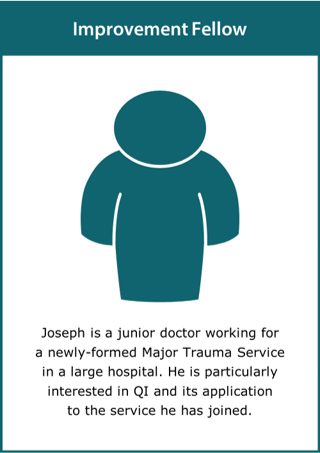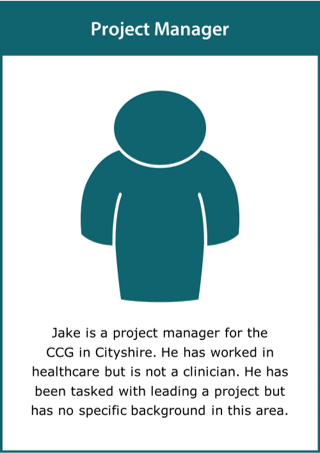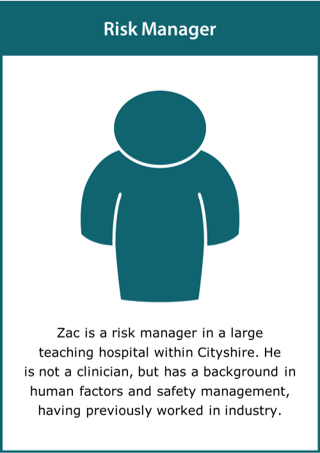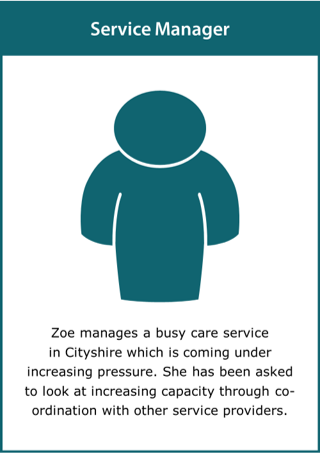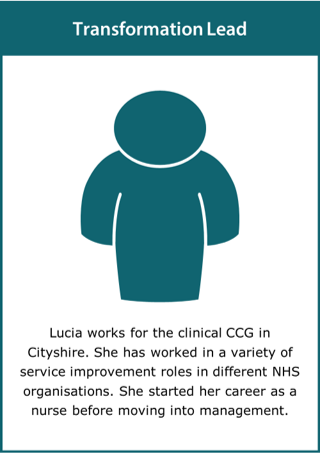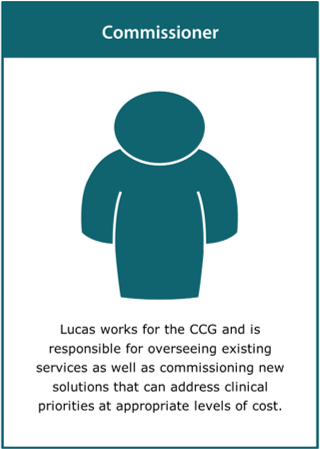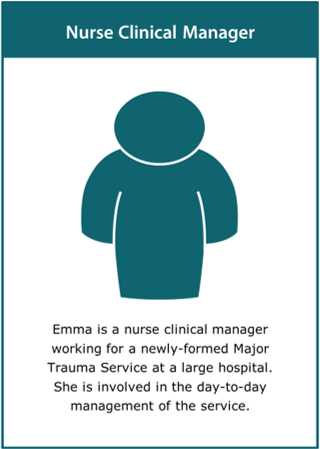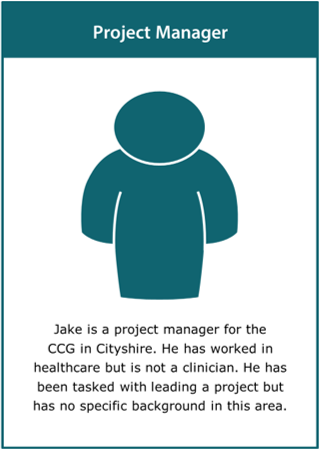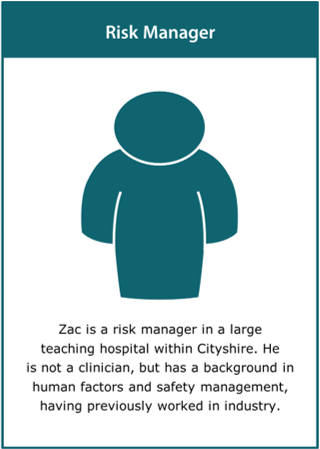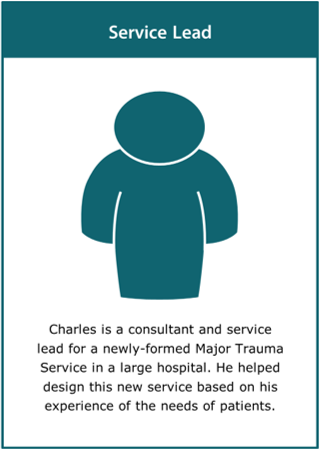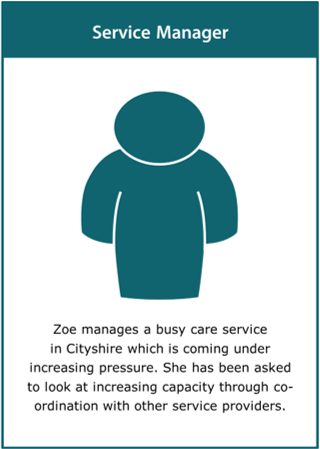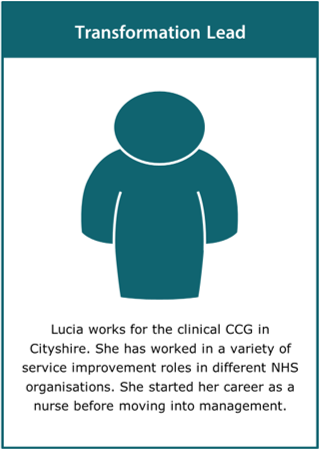A service improver is someone whose capacity for system improvement is enabled and enhanced by use of this toolkit.
Contents
Introduction
Descriptions of potential toolkit users are useful in reminding improvement managers who will use the toolkit. Knowledge and understanding of the needs and aspirations of such users, and their capabilities and limitations in engineering and healthcare approaches to systems improvement, provide crucial insights for those responsible for improving care. A useful way to capture and convey descriptions of these users is to use personas, or caricatures of people, designed to display certain pertinent attributes.
Personas can be used to represent different groups of people, describing not only typical users, but also a range of non-typical, or rarer, characteristics of individuals. They can also be used to deliberately emphasise certain characteristics or behaviours as a means to ensure that the service is designed to be as inclusive as possible. Personas are fictional characters, but can be inspired by knowledge of real people. They can represent members of the general population or be chosen to be more representative of a particular patient or care population.
This section describes a number of personas, representing people at different stages of the life course. They are typical of personas in that they convey some personal information about the individual along with a more factual description of their condition or capabilities. They are intended to represent a wide spectrum of the public, with no particular bias towards any clinical condition, and inspire the creation of further, and potentially more bespoke, personas as required.
Personas represent real people. They help system improvement teams to keep in mind the needs of patients or the public in their work. As a result, it is important that the personas used in any given programme of improvement form a representative set, describing all possible patients or service users.
Personas should be named and annotated with simple demographic data and details of their medical condition. In addition, their goals, challenges and habits should be presented, remembering that patients are also people. Sets of personas should have complementary descriptions, representing the population of service users, and may be related or linked in some way.
Personas inspire creative thinking when improvers are trying to conceptualise new services. They also provide assistance in the evaluation of the performance of current or new services. In both cases, improvers, putting themselves in the shoes of personas, can reimagine how a service performs or might perform from the perspective of each persona, arguing the case for particular consideration of their individual capabilities and needs. This ensures that services are improved with a wide range of service users in mind.
The selection or creation of personas is an important step for any improvement team and due thought should be given the role and value of using such personas in the improvement process. There should be clarity and consensus on what constitutes a sufficient set of personas for this task, in order that new personas can be created or existing ones selected and the completed set circulated to the team.
Finally, it is important to note that while personas provide a convenient reminder of the needs of service users, they are no replacement for engagement with real individuals. Hence, the challenge in any improvement programme is to find the appropriate balance between the cost and benefit of learning from literature, data, protocols, personas and real people.
Useful toolkit resources: Cards for each of these personas are included in the Resources part of this toolkit. A number of blank cards are included to allow additional personas to be added.
Text list of Personas
Pictorial list of Personas
You can click on any of the images below to find out more about that persona.
Cards for each of the personas are available in the boxed version of this toolkit. If you would like further information on how to get hold of these cards, please contact edc-toolkit@eng.cam.ac.uk
Personas
Clinical Lead
Amari is a consultant who is looking at making service improvements in a large teaching hospital in Cityville to address the growing demands due to an ageing population.
What matters to Amari:
- Clear local clinical benefit with wider potential impact
- Credible evidence base that the process will work
- Time and cost effectiveness to maximise engagement
Back to text list of Personas | Back to pictorial list of Personas
Commissioner
Lucas works for the CCG and is responsible for overseeing existing services as well as commissioning new solutions that can address clinical priorities at appropriate levels of cost.
What matters to Lucas:
- A commitment to meet clinical and operational priorities
- A costed and credible clinical case allied to a viable plan for change
- Ideally a short to medium term payback period
Back to text list of Personas | Back to pictorial list of Personas
Improvement Fellow
Joseph is a junior doctor working for a newly-formed Major Trauma Service in a large hospital. He is particularly interested in QI and its application to the service he has joined.
What matters to Joseph:
- Mix of clinical time and protected time for quality improvement
- Ability to apply the questions from the system approach
- Use of a practical process view of the Systems Approach
Back to text list of Personas | Back to pictorial list of Personas
Nurse Clinical Manager
Emma is a nurse clinical manager working for a newly-formed Major Trauma Service at a large hospital. She is involved in the day-to-day management of the service.
What matters to Emma:
- Effective management of the new trauma service
- Data collection for service monitoring and improvement
- Opportunity to learn about the Systems Approach
Back to text list of Personas | Back to pictorial list of Personas
Project Manager
Jake is a project manager for the CCG in Cityshire. He has worked in healthcare but is not a clinician. He has been tasked with leading a project but has no specific background in this area.
What matters to Jake:
- Process leads to a clear plan and set of actionable activities
- Process works within organisational processes and constraints
- Process helps coordinate different inputs from a variety of sources
Back to text list of Personas | Back to pictorial list of Personas
Risk Manager
Zac is a risk manager in a large teaching hospital within Cityshire. He is not a clinician, but has a background in human factors and safety management, having previously worked in industry.
What matters to Zac:
- Risks are systematically identified, reviewed and documented
- Mitigation strategies are developed and system changes risk assessed
- A proactive risk mindset is instilled in all stakeholders
Back to text list of Personas | Back to pictorial list of Personas
Service Lead
Charles is a consultant and service lead for a newly-formed Major Trauma Service in a large hospital. He helped design this new service based on his experience of the needs of patients.
What matters to Charles:
- Continuous development and improvement of the new service
- Engagement with a team who understand QI approaches
- Opportunity to learn more about the Systems Approach
Back to text list of Personas | Back to pictorial list of Personas
Service Manager
Zoe manages a busy care service in Cityshire which is coming under increasing pressure. She has been asked to look at increasing capacity through co-ordination with other service providers.
What matters to Zoe:
- That any solutions will work at day-to-day operational level
- That the patient experience is maintained or enhanced
- That staff issues and risks are understood and acted upon
Back to text list of Personas | Back to pictorial list of Personas
Transformation Lead
Lucia works for the clinical CCG in Cityshire. She has worked in a variety of service improvement roles in different NHS organisations. She started her career as a nurse before moving into management.
What matters to Lucia:
- The clinical need and case for change are made clear
- Strong clinical support with high domain knowledge and experience
- Sufficient budget for a programme of work to address the need
Back to text list of Personas | Back to pictorial list of Personas
Literature
Adlin T and Pruitt J (2010). The Essential Persona Lifecycle: Your Guide to Building and Using Personas. Morgan Kaufmann
Cooper A (2004). The Inmates Are Running the Asylum: Why High Tech Products Drive Us Crazy and How to Restore the Sanity. 2nd Edition, Sams.
Dam R and Siang T (2019). Personas — A Simple Introduction, Today. Interaction Design Foundation, https://www.interaction-design.org/literature/article/personas-why-and-how-you-should-use-them.
Goodwin K, Cooper A (2009). Designing for the Digital Age: How to Create Human-Centered Products and Services, Wiley.
LeRouge C, Sneha S and Tolle K (2013). User profiles and personas in the design and development of consumer health technologies. International Journal of Medical Informatics, 82(11):251-268.
Miaskiewicz T and Kozar KA (2011). Personas and user-centered design: How can personas benefit product design processes? Design Studies, 32(5):417-430.
Feedback
We would welcome your feedback on this page:
Privacy policy. If your feedback comments warrant follow-up communication, we will send you an email using the details you have provided. Feedback comments are anonymized and then stored on our file server
Read more about how we use your personal data. Any e-mails that are sent or received are stored on our mail server for up to 24 months.




